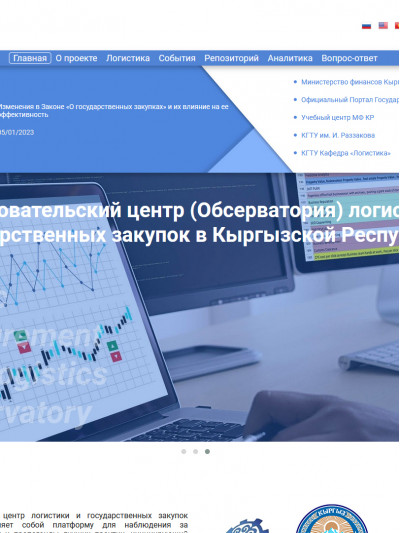
Annotation: I examined the use of the database of the "Analytics" module of the BI site pplo.kg at the design stage of public investment projects of the Kyrgyz Republic by procurement specialists. BI (Business Intelligence) is a business intelligence, an application to the site analytics section. This application is integrated with the API and processes data from the public procurement website online. I offered my recommendations on how and to what extent the use of the data in the "Analytics" section can affect the successful outcome of the projects.
Keywords: public investment projects, public procurement, procurement of goods, works and services, disbursement of state funds investment, project implementation.
Sharipova Elmira, master of the International School of Logistics of KSTU named after I. Razzakov.
The Kyrgyz Republic has been dependent on foreign assistance for many years and calls on donors (EBRD, ADB, WB, etc.) to implement national development strategies, to support the budget, to carry out reforms, and to implement infrastructure projects. This assistance is intended for the people of the Kyrgyz Republic, but it is used through state institutions and its use is subject to laws and regulations. Today, all assistance provided to the Kyrgyz Republic is carried out through state institutions. The procedure for initiating, selecting and preparing projects is spelled out in the regulation on public investment management. At the project preparation (design) stage, the Implementing Agencies involve independent experts, representatives of public or private organizations, and may also apply to donors for grant technical assistance for the preparation of project documentation or a feasibility study.
Further, we will talk about projects financed by the World Bank (WB). One of the key areas influencing the successful implementation of the project is the proper development of a procurement plan, in accordance with the planned activities of the Project and writing a procurement strategy. The Bank requires the Borrower to develop a Project Procurement for Development Strategy (PPSP) for each project financed under Investment Project Finance (IPF). The PPSP considers how procurement activities will support project development objectives and deliver Value for Money (VPM) using a risk-based approach. It shall provide adequate justification for the choice of selection methods contained in the Procurement Plan. The level of detail and analysis in the PPSP should be proportionate to the risk, cost and complexity of project procurement. The Initial Procurement Plan usually covers at least the first eighteen (18) months of the Project. All procurement under the Project is carried out in accordance with the procurement guidelines of a particular donor organization (Procurement Guidelines of the WB, ADB, EBRD, SFD, etc.). All project tenders, within the framework of projects, the implementation of which began after July 2016, must be registered and carried out on the state e-procurement portal. The government has adopted a new e-procurement procedure that includes a section related to market assessment and the establishment of a tender commission. In this edition, in chapter 2, paragraphs 13 and 14, states the following:
A well-designed procurement plan and a well-designed procurement strategy contribute to the successful implementation of the Project, the achievement of its goals and a high percentage of disbursement of funds. Here one cannot do without a deep analysis of many aspects, which is mentioned in the paragraphs above, and this work can be carried out on the basis of using the database of the "Analytics" module of the BI site pplo.kg, since BI (Business Intelligence) is a business intelligence, an application to site analytics. This application is integrated with the API and processes data from the public procurement website online.
There are three modules in this section:
Let's take a closer look at the first module.
1. Evaluation of the effectiveness of the public procurement system
The Public Procurement Business Intelligence Module is a free multifunctional tool that quickly and accurately helps you navigate the world of public procurement and gain insights into the performance of the public procurement function. The analytics module includes data on all public procurements that were carried out through the public procurement system of Kyrgyzstan.
There are many approaches to analyzing the effectiveness of public procurement. For the macro level, we are offered to evaluate the quality of the procurement process, to make sure that market relations work and there is no monopolization of the market.
Here for analysis, you can find charts for your analysis, such as:
There are many approaches to analyzing the effectiveness of public procurement. For the macro level, we are offered to evaluate the quality of the procurement process, to make sure that market relations work and there is no monopolization of the market.
Here for analysis, you can find charts for your analysis, such as:
All these modules work online and the information is relevant for study, in-depth analysis and application. All these tools and diagrams give us the opportunity to deeply analyze ongoing tenders in the country and review the overall picture and the situation in the market of suppliers and goods, and already having all this data, we can begin to develop a procurement strategy for the Project.
Unfortunately, not every Procurement specialist is familiar with this site, as a result of which he is deprived of an additional informative and analytical tool for analyzing data on tenders and procurement in the country. To do this, more work needs to be done to publicize the existence of this platform, as well as to s in the Terms of Reference for Procurement Specialists, the section “Responsibilities of the Consultant” the following paragraph: “The Procurement Specialist needs to review and study the website www.pplo.kg, in addition to other information platforms and portals, conduct an analysis, and apply the results obtained in the development and writing of the PPSD and the procurement plan.
Literature: